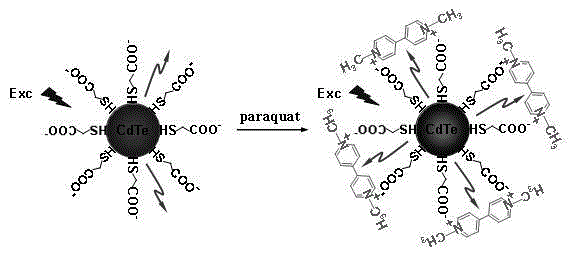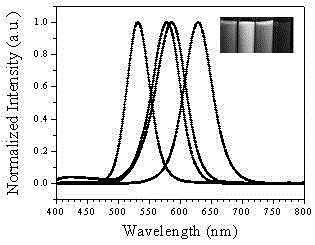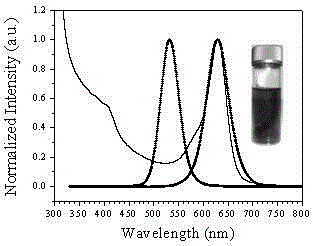Chemical preparation method for CdTe quantum dot fluorescent probe for detecting trace amount of paraquat
A technology of fluorescent probes and quantum dots, which is applied in the field of material science and can solve the problems of killing, narrowing the excitation spectrum, and limiting the number of fluorescent probes.
- Summary
- Abstract
- Description
- Claims
- Application Information
AI Technical Summary
Problems solved by technology
Method used
Image
Examples
preparation example Construction
[0044] A chemical preparation method for a CdTe quantum dot fluorescent probe for detecting trace amounts of paraquat, including modifying the surface of the CdTe quantum dot fluorescent probe with a red emission band to thioglycolic acid (TGA) to make the surface With carboxyl functional groups, it is characterized in that: the surface of the CdTe quantum dots has carboxyl groups, the negatively charged carboxyl groups on the surface and the positively charged target molecule paraquat through the electrostatic interaction of positive and negative charges, when the CdTe quantum dots and the target The molecular paraquat is close to each other in space. Through the principle of fluorescence resonance energy transfer, the emission spectrum of the CdTe quantum dot fluorescent probe is a red emission band that can be absorbed by the green target molecule paraquat. Using the change of the fluorescence intensity of the CdTe quantum dots, the realization For the detection of trace par...
Embodiment
[0048] Example: According to the interaction of positive and negative charges, using the prepared CdTe quantum dots as a support, a two-step reaction can be used to obtain a CdTe quantum dot fluorescent probe rich in carboxyl groups on the surface.
[0049] 1.1 The first step is the preparation of purple transparent NaHTe solution: First, weigh 0.12 g ~ 0.13 g tellurium powder and 0.07 g ~ 0.09 g sodium borohydride respectively, put them in a 50 mL three-necked flask, and then use a 1 mL micro injection Add 2 mL ~ 4 mL deionized water into a 50 mL three-neck flask, and react at 25 °C in a helium atmosphere until the black tellurium powder disappears, and a purple transparent NaHTe solution is obtained;
[0050] 1.2 The second step is to modify the surface of the red CdTe quantum dot fluorescent probe with thioglycolic acid in the emission spectrum: weigh 0.4 g ~ 0.5 g CdCl 2 2.5H 2 Dissolve O in a 50 mL three-neck flask, add 20 mL ~ 25 mL deionized water, sonicate for 3 ~ 5 m...
PUM
 Login to View More
Login to View More Abstract
Description
Claims
Application Information
 Login to View More
Login to View More - R&D
- Intellectual Property
- Life Sciences
- Materials
- Tech Scout
- Unparalleled Data Quality
- Higher Quality Content
- 60% Fewer Hallucinations
Browse by: Latest US Patents, China's latest patents, Technical Efficacy Thesaurus, Application Domain, Technology Topic, Popular Technical Reports.
© 2025 PatSnap. All rights reserved.Legal|Privacy policy|Modern Slavery Act Transparency Statement|Sitemap|About US| Contact US: help@patsnap.com



